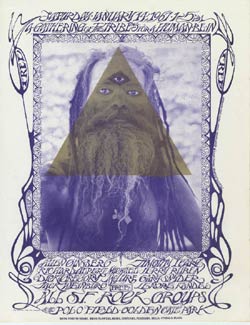Human Be-In
| Part of the Hippie movement | |
 Poster advertising the 'Human Be-In', designed by Stanley Mouse (artist) and Michael Bowen (concept), using the photograph of artist Casey Sonnabend | |
| Date | January 14, 1967 |
|---|---|
| Location | San Francisco, United States |
| Participants | Possibly 20,000–30,000 people |
| Outcome | Inspiration for the Summer of Love |
The Human Be-In was an event held in
Origins
Counterculture
The Human Be-In focused the key ideas of the
Protests
The Human Be-In took its name from a chance remark by the artist
Event
The Human Be-In was announced on the cover of the fifth issue of the
The national media were stunned, publicity about this event leading to the mass movement of young people from all over America to descend on the
Inspiration
The Human Be-In was organized mainly by Bowen with the assistance of poet Allen Cohen in the organizational work.[citation needed] The idea of the Human Be-In was born of a fear that the movement would be erased due to tensions between factions of the Hippie movement.[citation needed] Bowen writes "The anti-war and free speech movement in Berkeley thought the Hippies were too disengaged and spaced out. Their influence might draw the young away from resistance to the war. The Hippies thought the anti-war movement was doomed to endless confrontations with the establishment which would recoil with violence and fascism".[citation needed] They decided to thus create 'A Gathering of the Tribes', as the event was advertised on posters later on.[citation needed] This event would use musical performances , group meditation and chanting sessions, political rallies, and speeches to inspire all the factions that they had all joined this movement because they had the same beliefs: peace, love for one another, and freedom.[citation needed] This would be the first moment of true unification within the Hippie Movement in its history.[citation needed]
Legacy
The counterculture that surfaced at the "Human Be-In" encouraged people to "question authority" with regard to
A Human Be-In was put on in Denver, Colorado in July 1967 by Chet Helms and Barry Fey to harness the energy of the famed San Francisco event that occurred in January and promote their new Family Dog Productions venue, The Family Dog Denver.[13] The event attracted 5,000 people and featured performances by Grateful Dead, Odetta and Captain Beefheart. Timothy Leary and Ken Kesey were said to have also been in attendance.[14]
A "Digital Be-In" has been produced in San Francisco since 1989.[15]
A UK theatre company, Theatre 14167 (ddmyy), (also 14167 films) takes its name from the date of the Be-In; the company subsequently produced work by Michael McClure, who read at the event.[16]
See also
- Bed-In
- Central Park be-in
- Counterculture of the 1960s
- Teach-in
- Timeline of 1960s counterculture
Further reading
- Grogan, Emmett (1990). Ringolevio: A Life Played for Keeps. Citadel Press. ISBN 0-8065-1168-0.
Notes
- ^ Ringolevio p. 274 – The turkeys had been made into thousands of sandwiches under John-John's supervision, and the bread was salted down with crushed acid. Gary organized the free distribution of the sandwiches to those who looked like they needed something to eat, physically or spiritually.
- ^ Berkeley Barb, (Issue 73) – The two radical scenes are for the first time beginning to look at each other more closely. What both see is that both are under a big impersonal stick called The Establishment. So they’re going to stand up together in what both hope to be a new and strong harmony.
References
- ^ "American Experience Summer of Love". PBS. Archived from the original on 2015-09-24. Retrieved 2017-08-31. [dead link]
- ^ Goldberg, Danny (13 January 2017). "All the Human Be-In Was Saying 50 Years Ago, Was Give Peace a Chance". The Nation. Retrieved 12 January 2021.
- ^ Palmer, Steven. "The Human Be-In Teach-In". Oral History Masters of Arts. Columbia University. Retrieved 12 January 2021.
- ^ a b c Powis, Neville (22 January 2003). "The Human Be-In and the Hippy Revolution". Radio Netherlands Worldwide. Archived from the original on 21 April 2006. Retrieved 21 April 2006.
{{cite web}}: CS1 maint: bot: original URL status unknown (link) - ^ "Human Be-In". National Geographic Society. 2014-12-12. Archived from the original on 2017-08-17. Retrieved 2017-08-17.
- ^ "San Francisco Bay Guardian". sfbg.com.
- ^ New York Times 3/25/65.
- ^ "Reliving the Human Be-In 50 years later". San Francisco Chronicle. Archived from the original on 2017-08-17. Retrieved 2017-08-17.
- ^ ISBN 978-1-40271-442-9. Archivedfrom the original on 2017-02-17. Retrieved 2017-08-31.
- ISBN 0-8065-1168-0. Archivedfrom the original on 2008-02-04. Retrieved 2008-03-05.
- ISBN 978-0-74254-070-5. Archivedfrom the original on 2021-01-12. Retrieved 2020-11-12.
- ^ "Berkeley Barb, (Issue 73)". Independent Voices: An Open Access collection of an Alternative Press. 6 January 1967. Archived from the original on 12 January 2021. Retrieved 13 January 2017.
- ^ "The Tale of the Dog Documentary Uncovers a Gem from the 1960s". 5280. July 9, 2021.
- ^ "Hippie History: The Tale of the Dog Chronicles a Denver Rock Landmark". Westword. June 8, 2021.
- ^ "Digital Be-in". Jan 9, 2023.
- ^ Theatre Record, p. 846, 2006
External links
- Human Be-In - 1/14/1967 - Polo Fields, Golden Gate Park - San Francisco, CA, via Music Vault on YouTube:
- Human Be-In 50th Anniversary
- Allen Cohen's website, with history from an insider.
- Haight-Ashbury in the 1960s 'Rockument' commentary and sound bites.
- 1967 Berkeley Poster for 'Pow-Wow: A Gathering of the Tribes for a Human Be-In'
- Loren Sears' Human Be-In film at 'The Diggers Archive'
